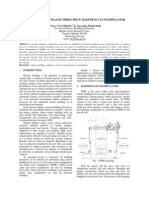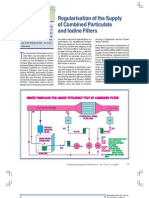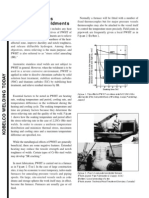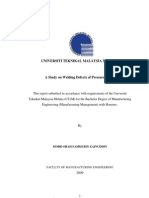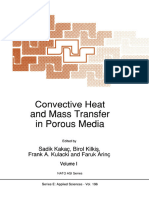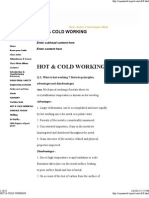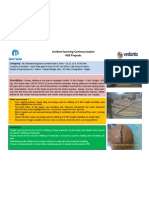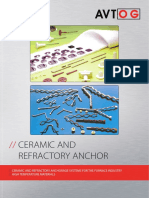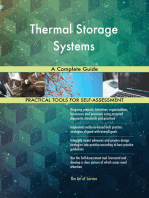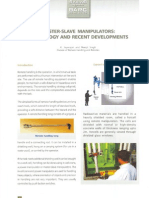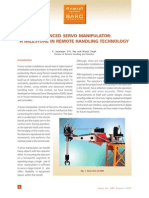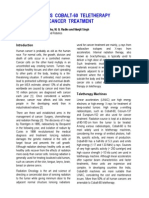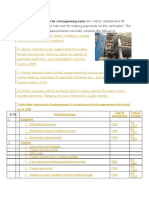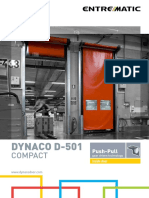Development of Hot Cells and Their Embedded Parts
Development of Hot Cells and Their Embedded Parts
Uploaded by
K. JayarajanCopyright:
Available Formats
Development of Hot Cells and Their Embedded Parts
Development of Hot Cells and Their Embedded Parts
Uploaded by
K. JayarajanCopyright
Available Formats
Share this document
Did you find this document useful?
Is this content inappropriate?
Copyright:
Available Formats
Development of Hot Cells and Their Embedded Parts
Development of Hot Cells and Their Embedded Parts
Uploaded by
K. JayarajanCopyright:
Available Formats
CONTENTS
BARC NEWSLETTER
Founders Day
PREVIOUS
Home
DEVELOPMENT OF HOT CELLS AND THEIR
EMBEDDED PARTS
K. Jayarajan, B. Sony, V.K. Shrivastava, R. Sahu, S. Panda, A.N. Jha, M.N. Rao
Division of Remote Handling and Robotics
Vivek Mahadev
Seismology Division
A.K. Pradhan
Isotope Application Division
S. Sethi, S.P. Dey, K. Karmakar, S.B. Gaikwad
Laser and Plasma Technology Division
V.R. Bhave, Kuldeep Sharma
Sealed Sources and Logistics, BRIT
Anwer Tariq
RAPP Cobalt Handling Facility, BRIT
Shri K. Jayarajan is the recipient of the DAE Group Achievement
Award for the year 2012
Abstract
Hotcell facilities are used for handling radioactive materials for various applications, like waste management,
radioisotope production and post-irradiation examination. We have been involved in the development of hot cells,
water pools and associated equipments. Hot cell embedded parts like personal assess doors, external transfer
drawers, inter-cell transfer drawer, wall sleeves, plugs and hot cell liners play a major role in the operation of the
plant and safety of the operators. The article describes our recent experience in development of these components.
Introduction
In nuclear industry, shielded nuclear radiation
containment chambers are referred as hot cells. They
protect operators and the environment from the
harmful effects of radiation. Hot cell walls are made
from lead-bricks or from concrete. Thickness of the
concrete wall vary from 1 m to 2 m depending upon
the shielding requirements.
The walls and the floor of hot cells are embedded
with a variety of equipments or components.
Embedded parts (EPs), such as wall liners, wall sleeves
and rails are static. However, EPs like access door,
142
Special Issue | October 2014
inter-cell transfer drawer and external transfer drawer
contain heavy moving parts. These EPs maintains
shielding integrity during normal and accidental
conditions. Safety inter locks are provided on
dynamic EPs to avoid accidental exposure of radiation
to operator.
CCTV cameras or radiation shielding windows are
used for viewing the hot cell. Objects in the hot cells
are usually handled using general-purpose remote
handling tools like Master Slave Manipulators, Power
Manipulators and In-cell Cranes. Viewing systems and
remote handling tools are not in the scope of the
article.
NEXT
BARC NEWSLETTER
Founders Day
Recently, we have been involved in development of hot
cells and associated embedded parts for the following
facilities.
Augmentation of Cobalt Handing Facility, Kota
(ACHF)
Augmentation of Hotcell and Associated Facilities
for Radiation Technology Applications, Trombay
(AHCAFRTA)
Integrated Facility for Radiation Technology, Vashi
(IFRT) and
Uranium Clean-Up Facility, Trombay (UCUF).
In ACHF hot cells, the adjuster rods are processed to
recover cobalt-60 pencils and pellets for making sealed
sources. Fig.1 shows irradiated adjuster rod subassemblies of power reactors placed in the RAPPCOF
Water Pool.
Fig. 2 shows the plan view of a typical hot cell facility
indicating commonly used EPs. The hot cells (red
zone) are connected to the high bay area (green zone)
through isolation rooms (amber zone) as per radiation
zoning principle.
Fig. 3 shows the sectional end view of one of the hot
cells.
Fig. 3 EPS and Remote Handling Tools of a Hot Cell (Side view)
Common Embedded Parts
Personal Access Door
Personal access doors are used for personnel entry into
the hot cell and for transferring radioactive materials
between the cold area and the hot cell in shielded
flasks. Access doors are of two types: hinged or sliding.
Fig. 1: Irradiated Adjuster Rod Sub-assemblies at RAPPCOF
Water Pool
Fig. 2: Major EPs of a Typical Hot Cell (Top View)
Fig. 4: Personal Access Door of ACHF, Kota at Fabricators
Shop
Special Issue | October 2014
143
BARC NEWSLETTER
Founders Day
They may be motorised or manual. Mild steel doors
are designed to provide radiation-shielding equivalent
that of the concrete cell wall. Fig.4 shows the door
designed by us for ACHF, Kota. The mild steel door
weighing about 45 tons has a door flap thickness of
600 mm.
on a trolley. Rails are laid on the floors of hotcell and
outside for transferring the trolley. Turntables are
provided at the junctions of the rails. The rails in the
hot cell are lined with stainless steel plates.
External Transfer Drawer
Walls and floor of the hot cells are lined with stainless
steel plates for easy decontamination. The stainless
steel plates are welded to the grid embedded in to the
wall or floor.
The external transfer drawer embedded in the
concrete wall is used for transferring materials into
the hot cell from outside and vice versa. It has two
shielded doors, a transfer drawer and mechanisms for
operating the doors and the transfer drawer. The doors
are mechanically interlocked to avoid simultaneous
opening of both doors.
Inter-cell Transfer Drawer
The inter-cell transfer drawer, embedded in the
common wall of adjacent hot cells, is used for
transferring materials from one hot cell to the other.
It consists of an outer casing, two shielded doors, a
transfer drawer and remote mechanisms for operating
the doors and the drawer. The doors are mechanically
interlocked to avoid simultaneous opening of both
doors.
Service Sleeves and Plugs
For transmission of electric power, electric signal,
pneumatic supply, etc. across the hot cell walls, service
sleeves and plugs are provided on the walls. The plugs
are housed in the sleeves, which are embedded in
the wall. Their shapes are designed to avoid direct
radiation streaming.
Rails and Turntables
Active components are transferred between the water
pool and the hot cells in heavy shielded flask placed
144
Special Issue | October 2014
Hot Cell Liner
Water Pool Liner
Leak tightness is one of the major requirements of any
storage pool in a nuclear installation. As the first barrier
of leakage, the walls and the floors of the pools are
lined with stainless steel plates. The liner is designed
to withstand internal as well as external hydrostatic
pressure. Stringent quality control is implemented to
ensure leak tightness.
Lead Bricks
In place of concrete, mild steel encased lead bricks can
be used to construct the walls of a hot cell. Although
expensive, it will significantly reduce the thickness of
hot cell walls. To avoid radiation streaming, the bricks
are made with interlocking edges. Such lead bricks are
used in two wall of the alpha- beta- gamma shielded
hot cell of UCUF.
Conclusion
Embedded parts of hot cells play a major role in the
operation of the plant and safety of the operators. EPs
of our design are installed in the hot cells of AHCF,
ACHFRTA, IFRT and UCUF. ACHF is operational at
RAPPCOF, Kota. It has been producing and supplying
Industrial Irradiator Sources and Tele-therapy Sources
of cobalt-60.
You might also like
- Charpy On - 196CDocument7 pagesCharpy On - 196CDhatchana moorthy.SNo ratings yet
- Development of Sealed Three Piece Master Slave ManipulatorDocument5 pagesDevelopment of Sealed Three Piece Master Slave ManipulatorK. JayarajanNo ratings yet
- Sanyo User Manul-2012 VersionDocument158 pagesSanyo User Manul-2012 VersionAliRouyou67% (12)
- Chapter 13, Subject 3 Protocol For Carrying Out Heat-Penetration StudiesDocument15 pagesChapter 13, Subject 3 Protocol For Carrying Out Heat-Penetration StudiesVannizsa IbañezNo ratings yet
- Rate AnalysisDocument75 pagesRate AnalysisRamesh100% (5)
- LR - Material and Qualification Procedures For ShipsDocument17 pagesLR - Material and Qualification Procedures For ShipsprasetyoNo ratings yet
- Iodine FilterDocument5 pagesIodine FilterRajeev Kumar GuptaNo ratings yet
- Laser Dismantling of PHWR Spent Fuel Bundles and De-Cladding of Fuel Pins in The Highly Radioactive Hot CellsDocument6 pagesLaser Dismantling of PHWR Spent Fuel Bundles and De-Cladding of Fuel Pins in The Highly Radioactive Hot CellsK. JayarajanNo ratings yet
- ML041000284 PDFDocument19 pagesML041000284 PDFAnuj DeoNo ratings yet
- 288 Doe-Hdbk-1169-2003Document395 pages288 Doe-Hdbk-1169-2003Justinas Rimkus100% (1)
- MaterialsDocument36 pagesMaterialsGamalMahranNo ratings yet
- PWHT Determines The Quality of WeldmentDocument1 pagePWHT Determines The Quality of WeldmenttbmariNo ratings yet
- ProcessBuildingVentilationSystemDesignDescription - CM A ME 001 R6 PDFDocument37 pagesProcessBuildingVentilationSystemDesignDescription - CM A ME 001 R6 PDFShaimaa SaadNo ratings yet
- Pressure Vessel Series Pressure Vessel Series: ASME VIII Division 1 & 2 ASME VIII Division 1 & 2Document6 pagesPressure Vessel Series Pressure Vessel Series: ASME VIII Division 1 & 2 ASME VIII Division 1 & 2process processNo ratings yet
- BY Arpit Mistry Abhishek ChavanDocument18 pagesBY Arpit Mistry Abhishek ChavantechbhazNo ratings yet
- A Study On Welding Defects of Pressure VesselDocument24 pagesA Study On Welding Defects of Pressure Vesseladamahmad1992100% (1)
- Modeling and Analysis of Solid Vessel and Multilayered Composite Pressure VesselsDocument62 pagesModeling and Analysis of Solid Vessel and Multilayered Composite Pressure VesselsWebsoft Tech-HydNo ratings yet
- Asme Sa-836 Specification For Forgings, Titaniumstabilized Carbon Steel, For Glass-Lined Piping and Pressure Vessel ServiceDocument5 pagesAsme Sa-836 Specification For Forgings, Titaniumstabilized Carbon Steel, For Glass-Lined Piping and Pressure Vessel Servicelucecita1902No ratings yet
- NPTEL - Vacuum TechnologyDocument38 pagesNPTEL - Vacuum Technologyавдей александрNo ratings yet
- Scraped Surface Continuous CrystallizersDocument1 pageScraped Surface Continuous CrystallizersLuis Velez100% (1)
- Hot Isostatic Pressing (HIP) E28093 The Fundamentals Industrial Applications and BenefitsDocument3 pagesHot Isostatic Pressing (HIP) E28093 The Fundamentals Industrial Applications and BenefitsziletoomuchmillionsNo ratings yet
- ATB 021 Flowtite Pipe Tapping PDFDocument10 pagesATB 021 Flowtite Pipe Tapping PDFRajadurai SinghNo ratings yet
- Piping Codes ListingDocument42 pagesPiping Codes ListingSamuel AnemeNo ratings yet
- F10ca004-Gb 0597Document8 pagesF10ca004-Gb 0597gabyorNo ratings yet
- Glovebox FabricationDocument44 pagesGlovebox FabricationRezaNo ratings yet
- DXF FormatDocument208 pagesDXF Formatthigopal100% (1)
- Best Practice Fluid Piping & InsulationDocument40 pagesBest Practice Fluid Piping & InsulationAlkesh BhatiNo ratings yet
- Interview QuestionsDocument2 pagesInterview QuestionsStarla HillNo ratings yet
- Cat Bpe PDFDocument57 pagesCat Bpe PDFJohnNo ratings yet
- 3 Pressure Vessels Design Manufacturers MersenDocument12 pages3 Pressure Vessels Design Manufacturers MersenekinathNo ratings yet
- LESER - Pilot Operated Safety Valve From LESERDocument2 pagesLESER - Pilot Operated Safety Valve From LESERAgis Rijal AtmawijayaNo ratings yet
- Welding of Stainless Steel - Sndo KouDocument17 pagesWelding of Stainless Steel - Sndo KouGovind RajNo ratings yet
- Lloyd S Register Sec. III 2015 Edition OverviewDocument23 pagesLloyd S Register Sec. III 2015 Edition OverviewYoshua PortugalNo ratings yet
- BPE Technical DataDocument5 pagesBPE Technical Datasmtamaskar2277No ratings yet
- Convective Heat and Mass Transfer in Porous Media 1991Document1,083 pagesConvective Heat and Mass Transfer in Porous Media 19917dnp2yypcgNo ratings yet
- Pressure Vessel Design PDFDocument103 pagesPressure Vessel Design PDFJaeup YouNo ratings yet
- Hot & Cold WorkingDocument18 pagesHot & Cold WorkingMadushan MadushaNo ratings yet
- Preliminary Documentation PDFDocument63 pagesPreliminary Documentation PDFShirish GuravNo ratings yet
- Pap 2Document68 pagesPap 2Aziz SyahrizalNo ratings yet
- Incident Learning BalcoDocument1 pageIncident Learning BalcothehinduNo ratings yet
- 11 Heat Transfer To The Riser Wall of A Circulating Fluidised Bed CFBDocument8 pages11 Heat Transfer To The Riser Wall of A Circulating Fluidised Bed CFBMahesh DasarNo ratings yet
- Tori SphericalDocument62 pagesTori SphericalWebsoft Tech-Hyd0% (1)
- Ceramic and Refractory Anchor Catalog Avtog 5Document4 pagesCeramic and Refractory Anchor Catalog Avtog 5MaximilianoRodrigoCabestreroNo ratings yet
- Vendor Document Cover Sheet: Project: Ar4 4 Aromatics PlantDocument18 pagesVendor Document Cover Sheet: Project: Ar4 4 Aromatics PlantHyune Boom SheenNo ratings yet
- Buckling Stability Assessment of Plates PDFDocument9 pagesBuckling Stability Assessment of Plates PDFAryan BhattaraiNo ratings yet
- Iso 17874 2 2004Document15 pagesIso 17874 2 2004fahadkhanffcNo ratings yet
- Is 15287 1 2003Document12 pagesIs 15287 1 2003Alejandro GilNo ratings yet
- Corrosion Resistance ofDocument44 pagesCorrosion Resistance ofalkem7No ratings yet
- PDFDocument69 pagesPDFSlobodan GaricNo ratings yet
- Material HandlingDocument4 pagesMaterial Handlingshareupload0% (1)
- A Technical Report On Shielded Meatal Arc Welding: Group 5 Grade 12 DDocument5 pagesA Technical Report On Shielded Meatal Arc Welding: Group 5 Grade 12 DJohn Lloyd CapaoNo ratings yet
- Limits, Fits & CalculationsDocument28 pagesLimits, Fits & Calculationsagniva dattaNo ratings yet
- Bolted Flanged Joint: Flanges, Studs & Gaskets. Recommended Practices for the Assembly of a Bolted Flange Joint.From EverandBolted Flanged Joint: Flanges, Studs & Gaskets. Recommended Practices for the Assembly of a Bolted Flange Joint.No ratings yet
- Transport Processes in Chemically Reacting Flow SystemsFrom EverandTransport Processes in Chemically Reacting Flow SystemsRating: 5 out of 5 stars5/5 (1)
- Damage Mechanics in Metal Forming: Advanced Modeling and Numerical SimulationFrom EverandDamage Mechanics in Metal Forming: Advanced Modeling and Numerical SimulationRating: 4 out of 5 stars4/5 (1)
- Everybody Needs a Screw: What I Learned from Selling Fasteners for Forty YearsFrom EverandEverybody Needs a Screw: What I Learned from Selling Fasteners for Forty YearsNo ratings yet
- In-situ Characterization of Heterogeneous CatalystsFrom EverandIn-situ Characterization of Heterogeneous CatalystsJosé A. RodriguezNo ratings yet
- The Working of Steel: Annealing, Heat Treating and Hardening of Carbon and Alloy SteelFrom EverandThe Working of Steel: Annealing, Heat Treating and Hardening of Carbon and Alloy SteelNo ratings yet
- Suspendable Servo Manipulator For Hot Cell ApplicationDocument4 pagesSuspendable Servo Manipulator For Hot Cell ApplicationK. JayarajanNo ratings yet
- Development of An Advanced Servo Manipulator For Remote Handling in Nuclear InstallationsDocument8 pagesDevelopment of An Advanced Servo Manipulator For Remote Handling in Nuclear InstallationsK. JayarajanNo ratings yet
- Development of Type B (U) Package For Cobalt-60 Teletherapy Source TransportationDocument5 pagesDevelopment of Type B (U) Package For Cobalt-60 Teletherapy Source TransportationK. JayarajanNo ratings yet
- Master-Slave Manipulators: Technology and Recent DevelopmentsDocument11 pagesMaster-Slave Manipulators: Technology and Recent DevelopmentsK. Jayarajan100% (2)
- Advanced Servo Manipulator: A Milestone in Remote Handling TechnologyDocument12 pagesAdvanced Servo Manipulator: A Milestone in Remote Handling TechnologyK. Jayarajan0% (2)
- Bhabhatron: An Indigenous Telecobalt Machine For Cancer TreatmentDocument8 pagesBhabhatron: An Indigenous Telecobalt Machine For Cancer TreatmentK. JayarajanNo ratings yet
- BARC Develops Cobalt-60 Teletherapy Machine For Cancer TreatmentDocument6 pagesBARC Develops Cobalt-60 Teletherapy Machine For Cancer TreatmentK. JayarajanNo ratings yet
- Development of Automatic Remotely Operable Laser Cutting System For Disassembly of PHWR Spent Fuel BundlesDocument7 pagesDevelopment of Automatic Remotely Operable Laser Cutting System For Disassembly of PHWR Spent Fuel BundlesK. JayarajanNo ratings yet
- Drawing 1493654Document7 pagesDrawing 1493654Kaezil Mae ZapantaNo ratings yet
- Getting Started... : A Planning GuideDocument35 pagesGetting Started... : A Planning GuidejoependerNo ratings yet
- Union - Trade Catalogue - REDDocument127 pagesUnion - Trade Catalogue - REDOnesmas TwinomugishaNo ratings yet
- WIDELINE Timber Entry Frames Standard SizeDocument1 pageWIDELINE Timber Entry Frames Standard SizeManasi SatbhaiNo ratings yet
- 15 Portable LaddersDocument55 pages15 Portable LaddersExcequiel QuezadaNo ratings yet
- ABB Duty Selector SwithDocument68 pagesABB Duty Selector SwithfayasNo ratings yet
- INSTALLATION, OPERATION AND SaldaDocument104 pagesINSTALLATION, OPERATION AND SaldaAleksejs KuļikovsNo ratings yet
- KATALOG Huppe Alpha Tus KabineDocument11 pagesKATALOG Huppe Alpha Tus KabineSuzanaDjNo ratings yet
- Container SpecificationsDocument46 pagesContainer SpecificationsPARALELO10100% (1)
- Garage Storage Solutions PDFDocument36 pagesGarage Storage Solutions PDFKimNo ratings yet
- The Units of Measurements For Civil Engineering WorksDocument4 pagesThe Units of Measurements For Civil Engineering Workskrishnashankar9_3743No ratings yet
- 2021 - 2022 - Katalog - en Pol-EkoDocument118 pages2021 - 2022 - Katalog - en Pol-EkorafaelNo ratings yet
- Front Elevation: 200 MM 700 MMDocument7 pagesFront Elevation: 200 MM 700 MMGee Madrigal MagmanlacNo ratings yet
- The Goodheart-Willcox Co., Inc.: Publisher Tinley Park, IllinoisDocument47 pagesThe Goodheart-Willcox Co., Inc.: Publisher Tinley Park, IllinoisSaurav ShresthaNo ratings yet
- Disability CodeDocument16 pagesDisability CodeMarianNo ratings yet
- Garbag Linen ChutesDocument24 pagesGarbag Linen Chutessultanprince100% (1)
- 2019 Midterm Elections HandbookDocument101 pages2019 Midterm Elections Handbookanon_234569225No ratings yet
- D-501 Compact 2Document4 pagesD-501 Compact 2Tarik MuhamedagicNo ratings yet
- M-Braun Glovebox System Operation ProcedureDocument5 pagesM-Braun Glovebox System Operation ProcedureharNo ratings yet
- Electrolux Ewf12853-Installation-Guide-En-MyDocument4 pagesElectrolux Ewf12853-Installation-Guide-En-MyOGStage2 ASNo ratings yet
- Technical Specifications 1. GeneralDocument12 pagesTechnical Specifications 1. GeneralBuoyancyNo ratings yet
- Hill Side Leaflet CompressedDocument7 pagesHill Side Leaflet Compressedanyam.research.iiithNo ratings yet
- EP-DP-C1 Electricity Planning Regulations For Supply-FinalDocument27 pagesEP-DP-C1 Electricity Planning Regulations For Supply-FinalVladimir Simeunovic100% (2)
- MEchanical Spec 17-02-10Document344 pagesMEchanical Spec 17-02-10Osama HabboobNo ratings yet
- Practical 3Document11 pagesPractical 3Tahir Hussain SoomroNo ratings yet
- Rosario Estimates For BLDG PermitDocument9 pagesRosario Estimates For BLDG PermitMc R OnNo ratings yet
- Singapore Fire Code 2007Document317 pagesSingapore Fire Code 2007Trương Văn Cường100% (1)
- MetroredDocument20 pagesMetroredIván López PavezNo ratings yet

